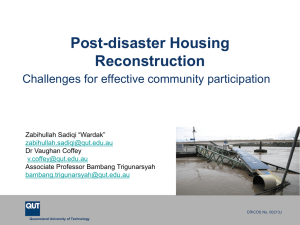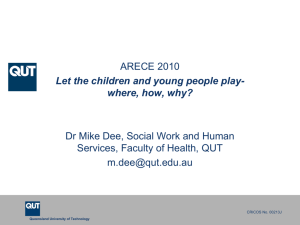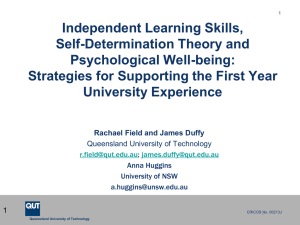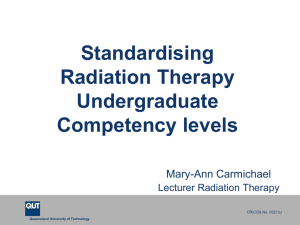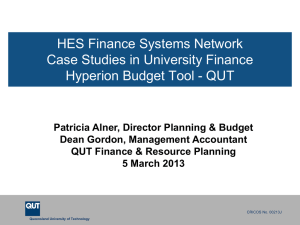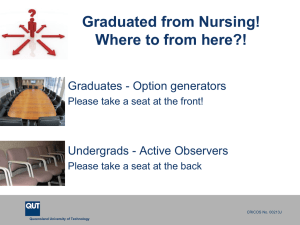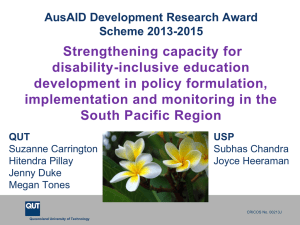real - University of Western Sydney
advertisement
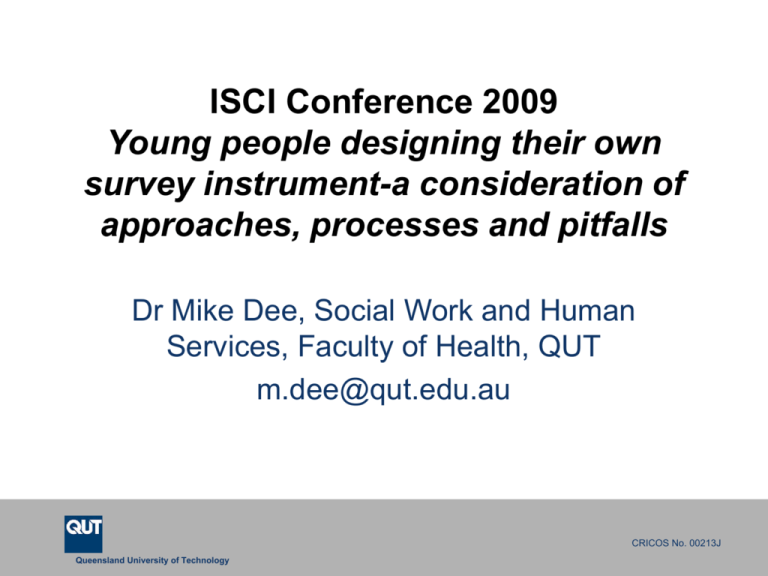
ISCI Conference 2009 Young people designing their own survey instrument-a consideration of approaches, processes and pitfalls Dr Mike Dee, Social Work and Human Services, Faculty of Health, QUT m.dee@qut.edu.au CRICOS No. 00213J Queensland University of Technology What this brief presentation/paper is about…... • My Doctoral thesis on Young People, Public Space and Citizenship; • A survey of 1122 high school students in the greater Brisbane area; • The survey instrument was designed by a group of young people aged 14-19 to be administered to young people of the same age; • The survey instrument was tested by a group of young people in New Zealand before final revisions in Brisbane; • Methodological matters are discussed more fully in the paper partnering this presentation, but a mix of focus group work, a questionnaire and a modified Grounded Theory approach to data collection and analysis was taken; • QUT Ethics approval was granted for the work here describednames of youth councils/forums have been changed; • Education Queensland ethical clearance was also obtained. a university for the real world R CRICOS No. 00213J The Process-in brief • I worked closely with South City Youth Council• Took a draft survey document to North City Youth Forum, New Zealand (I was going there anyway) but they had been established as a result of a survey of young people so this was relevant; • Came back to South City for final approval, before taking the survey to 1122 high school students; • Most high schools didn’t ever reply to repeated requests, so 7 schools took part-they self selected. a university for the real world R CRICOS No. 00213J Summary of fieldwork sessions, South City Youth Council Venue: South City Council Chambers • Session 1: convened introductory evening with youth council members, to explain my research program and to seek their consent to involvement in devising and drafting the survey instrument. • Sessions 2 &3: conducted semi-structured conversations using a social planning approach (White 1999, 2001,Chawla 2002)) to identify and map the young people’s perceptions and concerns about living in South City, reflected on outcomes with participants, evaluated the process and took findings forward to next session on drafting the survey instrument. • Session 4: worked with group to discuss what questions could go in to the questionnaire, drafted questions, refined them and took them away. Got agreement from the group to test the survey with North City Youth Forum, New Zealand. • Session 5: returned with feedback from North City Youth Forum NZ, discussed their ideas and issues, reviewed the survey instrument, finalized it for use at South City State High School. a university for the real world R CRICOS No. 00213J The Survey Instrument • Young People, Public Space and Citizenship Survey at South City State High School • Queensland University of Technology, School of Humanities and Human Services thank you for completing this survey aimed at young people aged 14-25. It is confidential. Please complete all questions if you can. If you are unsure about the meaning of a question, please decide on it for yourself. • 1. As a young person, do you feel that you are negatively • stereotyped by people in the wider community? • 2. Do you think there are enough youth facilities in your area? • 3. How involved do you feel in your local community life? a university for the real world R CRICOS No. 00213J The Survey Instrument… • 4. Are you happy with the way your school/university/TAFE involves you in the community? • 5. Looking at things from your perspective, would you say that the wider community where you live is aware of or concerned about your safety? • 6. What does the word ‘Citizenship’ mean to you? 7. Are there public places such as malls, streets, parks and other places in your local area that you avoid due to safety issues? • 8. Is your school/university/TAFE a place you think of as safe? • 9. Do security cameras make you feel safe in using public places? • 10. Should there be more security cameras in your local area? a university for the real world R CRICOS No. 00213J The Survey Instrument…… • • • 11. 12. 13. • • • • • • • • • 14. • 15. 16. 17. What would make your use of public places more enjoyable? What would make your use of public places safer? Do you think using public places raises issues for the following? - people with disabilities - people who are gay, lesbian, bisexual - people from Indigenous backgrounds - any other people -people who are homeless? Do you consider yourself to be any/some/all of the above? If so, please say here if you wish………………………………. Please say whether you are: Male or Female Please give your age: Anything else you want to say? This survey was designed by the young people of South City Youth Council • a university for the real world R CRICOS No. 00213J Key themes emerging from the data • Theme One: Young people and trust: (focusing on mistrust of young people, dislike and lack of respect for young people, community, judgements, labelling and assumption making about young people. • Theme Two: Young people’s citizenship: (focussing on power, participation, decision making, exclusion, diminished inclusion, the place of young people in local community and society, belonging. • Theme Three: The condition of public space (focusing on the amenity of public space, play, enjoyment, safety, belonging, rights to public space, inclusion/exclusion). • Theme Four: Young people under suspicion (focussing on surveillance, security guards, restrictions, move on powers, over policing, under policing, curfews, monitoring, the category of young people including age, race and class) • Theme Five: Fear in public space: (focussing on feelings of exclusion and diminished inclusion in using public space a university for the real world R CRICOS No. 00213J Key points-lessons (not exhaustive) • • • • • • • • • • A belief in the value of listening to children and young people is central to undertaking the work (Kirby 2002); Use respect and care for the groups/individuals to be worked with (Mayall 1996, 2002); Confidentiality and other consent and ethical issues are central factors ( Valentine 1999, Bowling 2002); Many children and young people may be ‘over consulted’ by researchers, especially in schools, so be aware of this; Acknowledge power differentials-be honest about what’s in it for participants and for you and your institution (Lundy 2007); What counts as data? This is a key tension but important to advocate for capturing child and youth observations and life experiences as valid data (Morrow 2005); But..this data can be messy as well as rich and thick, possibly controversial and challenging-avoid quick media grabs? Are we ready for contradictory data from participants? Will it spoil the research plan-should participants fit the methodology or should the methods and methodology fit the context, participant’s situation and constraints? (Glaser and Strauss 1967, Punch 1999). What children and young people say should inform policy and can change things (Valentine 2004, Stanley 2005). See ARACY: Involving Children and Young People in Research (2009) a university for the real world R CRICOS No. 00213J Children and Young People Using Public Space • Using Public Space is important to the overall health and wellbeing of children and young people in allowing them to explore their local and wider community, meet up with friends, get some exercise and feel included in the society in which they live. • A problem exists in the capacity of modern, urban public space to genuinely accommodate children and young people’s need to experience excitement and fun in what has been termed “unprogrammed space” (Lynch 1977:71), or simply to ‘hang out’ in unstructured social space, with control by civic authorities a key concern (Valentine 1996, 2004, Harris, 2006, Gleeson and Snipe 2006). • For many children and young people, their experiences of attempting to use public space are sometimes marred by the denial of everyday rights and courtesies, in youth ‘unfriendly’ spaces. • Child and Youth Friendly spaces have important features as outlined in the 3 studies contained in Table 1. • Table 2 charts the range of factors in the gaining of rights to public space. • Table 3 represents the gaining of rights as a dynamic process. a university for the real world R CRICOS No. 00213J Table 1: Key factors in youth friendly public spaces: Wooden (1997) in Melton City, Victoria Chawla (2002) in an 8 country research project Dee (2008) in Brisbane and Logan Environment Acceptance Friendly people Good entertainment No violence Sense of safety No drugs or alcohol Affordability Support and help Under 18 places No adults or police Safety Free movement Places to meet Cheap transport Open politics No violence Spaces/places to hang out Other users about in public space Affordable transport Good environment Safety Affordability No violence No drugs Acceptance and belonging in the community a university for the real world R CRICOS No. 00213J Table 2: Child and youth rights in public space: a model in progress: Catalysts for change Social citizenship Physical factors Opportunities for change Threats to beneficial change Children and young people are valued more by society. Civil, social and political rights need to be extended to include health, education, work, housing, public space and economic rights more generally. Public space should be maintained and improved, taking the needs of children and young people into account and responding to ideas. Policing of public space can easily become more coercive, where risk management frames dominate all other considerations- (e.g. technical advances in CCTV can lead to more and more intrusive surveillance). Child and youth friendly spaces are more readily available. Citizenship at the maximal rather than minimal levelrecognising the affective dimensions of young people’s sense of belonging as a key part of social rights. Rights, standards, protections and expectations of all users of public space to be articulated. There is an opportunity to involve children and young people in negotiating new relationships with institutions, spaces and the community across generations. Key references: France(1997), Valentine (2004), White & Wyn (2004), Skelton (2007). Key references: Marshall (1950), Jacobs (1965), Tonkiss (2005), White & Wyn (2004). Key references: Chawla (2002), Malone (2006). The UNCROC is revised to be more inclusive of different youth and childhoods. a university for the real world Research demonstrates they have the capacity and interest and that a sense of belonging is key to their frame of citizenship. Key references: Chawla (2002), Heywood & Crane (1998), Dee (2008), White & Wyn (2004). The ‘new economy’ pushes young people to engage in ‘approved’ of leisure time tied to consumption, rather than ‘hanging out’. The impact of the Global Financial Crisis leads to greater impoverishment and control measures to maintain urban law and order. Anti-terrorism laws can often be used as a platform for further control measures in public space. Key references: Mitchell (2003), Watson (2006), Harris (2006). R CRICOS No. 00213J Child and youth rights to public space: possible stages in progress • Table 3: Public space is more child and youth friendly Optimal sociospatial conditions Citizenship has more meaning for children and young people as a greater sense of positive recognition, belonging and optimism is experienced a university for the real world The nature of institutional relationships changes R CRICOS No. 00213J Children and Young People Using Public Space: Models of Rights • In adopting an approach based on key social, civil and political rights, including the right to a sense of belonging, rather than the presumed wrongs of children and young people, their aspirations and potential come to prominence, requiring a policy response that is more sophisticated and genuinely engaging than may be the case currently (Gleeson and Snipe 2006; Franklin 2002; White and Wyn 2008). • In a multitude of ways in many locations worldwide, public spaces are under attack from developments and control measures seeking to exclude children, young people and others (Watson 2006). In this climate of rapid sometimes violent, change within the nature of public space, it is becoming increasingly and highly contested. • Perhaps there really cannot be too many rights which support the active use and enjoyment of all forms of public space, by children and young people. Gleeson (2006) suggests that viewing public space issues through the lens of social citizenship alongside the connected elements of civil and political citizenship, can revitalize and restore public space, something that ever increasing attempts at control, policing, camera surveillance and more stringent exclusion of ‘undesirables’, cannot achieve. • In promoting greater understanding and tolerance of the rights and needs of all users of public space, the spirit of Jacob’s (1965) hope for the generations to mix together, sharing community infrastructure and yet maintaining personal safety and dignity, might become a reality for more children and young people around the world. a university for the real world R CRICOS No. 00213J Key References • • • • • • • • • • • • • • • • • • • • • • • • • • • • • • • • • • • • • • • • • • • • • • Aitken, S. (2001). Geographies of Young People: The Morally Contested Spaces of Identity. London: Routledge. Alexander, C. (2000). The Asian Gang. Oxford: Berg. Alinsky, S. (1972). Rules for Radicals. New York: Vintage. Alston, M., & Bowles. W. (2003). Research For Social Workers: An introduction to methods (Second ed.). NSW: Allen & Unwin. Alveson, M. (2002). Postmodernism and Social Research. Buckingham: Open University Press. Amster, R. (2004). Street People And The Contested Realms Of Public Space. New York: LFB Scholarly Publishing LLC. Aries, P. (1962). Centuries of Childhood. London: Jonathon Cape. Article 12 (2000). Curfews and Crime-what young people think. Edinburgh, Save the Children Fund Scotland. www.article12.org Australian Research Alliance for Children and Youth (2006). A Framework for Child and Youth Friendly Communities. Bartlett, D., & Payne, S. (1997). Grounded Theory-Its Basis, Rationale and Procedures. In McKenzie, G., Powell, J., & Usher, R. (Eds.), Understanding Social Research: Perspectives on Methodology and Practice. London: The Falmer Press Basit, T. (1997). Eastern Values; Western Milieu. Aldershot: Ashgate. Baubock, R. (Ed.). (1994). From Aliens to Citizens. Aldershot: Avebury. Berger, P. & Luckmann, T. (1967). The Social Construction of Reality. London: Allen Lane. Bessant, J. (2003b). The Science of Risk and the Epistemology of Human Service Practice. Just Policy (31), 31-38. Blackman, S. (1995). Youth: Positions and Oppositions. Aldershot: Avebury. Bolzan, N. (2003). Kids are like that! Community attitudes to young people. Canberra: National Youth Affairs Research Scheme. Bowling, A. (2002). Research methods in health: investigating health and health services (2nd ed.). Buckingham: Open University Press. Bryman, A., & Burgess, R. (1994). Analyzing Qualitative Data. London: Routledge. Bryman, A., & Hardy, M. A. (2004.). Handbook of data analysis. London: SAGE. Byrne-Armstrong, H., Higgs, J., & Horsfall, D. (Eds.). (2001). Critical Moments in Qualitative Research. Oxford: Butterworth Heinemann. Chawla, L. (Ed.). (2002). Growing Up in an Urbanising World. London: UNESCO/Earthscan Publications. Cohen, P. (1997). Rethinking the Youth Question. London: Macmillan. Copeland, A. Public Space A rights-based approach. (2004) Youth Studies Australia, 23(3), 40-45. Corrigan, P. (1993). Doing nothing. In S. Hall, & Jefferson, T. (Eds), Resistance through Rituals. London: Routledge. Crane, P. and Richardson, L. (2000). Reconnect Action Research Kit. Queensland, Australia: Queensland University of Technology, School of Human Services, for Commonwealth Department of Family & Community Services, Youth & Students Branch. Crane, P. & Dee, M. (2001). Young people, public space & New Urbanism. Youth Studies Australia, 20(1), 11-18. Cresswell, J. (1994). Research Design, Qualitative and Quantitative Approaches. California: Sage. Denscombe, M. (1998). The good research guide: for small-scale social research projects. Buckingham: Open University Press. Denscombe, M. (2002.). Ground rules for good research: a 10 point guide for social researchers. Buckingham: Open University Press. Dey, I. (1999). Grounding Grounded Theory. London, Academic Press. De Vaus, D. A. (2002). Surveys in Social Research. Sydney, Allen and Unwin. Dick, B. (2004). Grounded theory: a thumbnail sketch. Retrieved September 29 2004, from http://www.scu.edu.au/schools/gcm/ar/arm/op016.html Driskell, D. (2002). Creating Better Cities with Children and Youth, A Manual For Participation. London: UNESCO/Earthscan Publishing. Dunedin Youth Forum (2003). Dunedin Youth Forum General Information Form. Dunedin, New Zealand: Dunedin Youth Forum Inc. France, A., Bendelow, G. and Williams, S. (2000). A 'risky' business: researching the health beliefs of children and young people. In Lewis, A. & Lindsay, G. (Eds.), Researching Children's Perspectives. Buckingham: Open University Press. Franklin, B. (Ed.). (2002). The New Handbook Of Children's Rights. London: Routledge. Freeman, C. (2006). Colliding worlds: planning with children and young people for better cities. In Gleeson, B & Snipe, N. (Eds.), Creating Child Friendly Cities. London: Routledge. Freeman, C. and. Riordan, T. (2002). Locating Skateparks: The Planners Dilemma. Planning Practice & Research, 17(3), 297-316. Freire, P. (1972). Pedagogy of the Oppressed. Harmondsworth: Penguin. Glaser, B., & Strauss, A. (1967). The Discovery of Grounded Theory-Strategies for Qualitative Research. Chicago: Aldine. Glaser, B., & Strauss, A. (1968.). Time for dying. Chicago: Aldine. Glaser, B. (1978). Theoretical sensitivity: advances in the methodology of grounded theory. Mill Valley, Calif: Sociology Press. R Glaser, B. (2003). The Grounded 2: Description’s Remodeling of Grounded Theory Methodology. Mill Valley CA: Sociology Press. a university forTheory the Perspectiveworld CRICOS No. 00213J Gleeson, B., Sipe, N. & Rolley, K. (2006). Pathways to the child friendly city. In Gleeson, B & Snipe, N. (Eds.), Creating Child Friendly Cities. London: Routledge. Gleeson, B. (2006). Australia's toxic cities: modernity's paradox. In Gleeson, B. & Snipe, N. (Eds.), Creating Child Friendly Cities. London: Routledge. Gleeson, B. & Snipe, N. (2006). Creating Child Friendly Cities. London: Routledge. real
